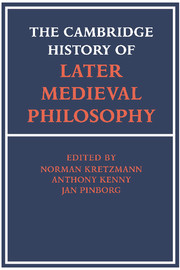 The Cambridge History of Later Medieval Philosophy
The Cambridge History of Later Medieval Philosophy from VII - Natural philosophy
Published online by Cambridge University Press: 28 March 2008
Natural philosophy, first philosophy, and moral philosophy
When the ‘new’ Aristotelian books of philosophy were incorporated into the curriculum of the medieval Faculty of Arts by 1252, they were simply added as ‘the three philosophies’ to an existing curriculum of the seven liberal arts, a course requiring up to eight years before one became a Regent Master. The ‘new logic’ (logica nova,) namely the two Analytics, Topics, and Elenchi, had merely expanded the old study of logic, which had even assimilated the logica modernorum without substantially changing the curriculum. But the addition of the hitherto proscribed (1210–ca. 1237) libri naturales and Metaphysics, together with the Nicomachean Ethics translated in full (1245–7) by Robert Grosseteste, expanded the curriculum substantially to include three new ‘sciences’: natural philosophy, first philosophy (or metaphysics), and moral philosophy. Thus during the second half of the thirteenth century was inaugurated what might be called the Faculty of Arts and Sciences.
The assimilation of the new learning
It was a period that saw an unprecedented assimilation of ‘the new learning’ not only in the Faculty of Arts, but more especially in the Faculty of Theology. However, the most notable assimilation and syntheses of the new learning both in philosophy and in theology were accomplished by theologians who had already passed through the university system and embarked on their own re-thinking of Christian truths ‘new and old’. This was particularly true of such leading scholars as Robert Grosseteste, Albert the Great, Thomas Aquinas, Roger Bacon, and later Thomas Bradwardine.
To save this book to your Kindle, first ensure [email protected] is added to your Approved Personal Document E-mail List under your Personal Document Settings on the Manage Your Content and Devices page of your Amazon account. Then enter the ‘name’ part of your Kindle email address below. Find out more about saving to your Kindle.
Note you can select to save to either the @free.kindle.com or @kindle.com variations. ‘@free.kindle.com’ emails are free but can only be saved to your device when it is connected to wi-fi. ‘@kindle.com’ emails can be delivered even when you are not connected to wi-fi, but note that service fees apply.
Find out more about the Kindle Personal Document Service.
To save content items to your account, please confirm that you agree to abide by our usage policies. If this is the first time you use this feature, you will be asked to authorise Cambridge Core to connect with your account. Find out more about saving content to Dropbox.
To save content items to your account, please confirm that you agree to abide by our usage policies. If this is the first time you use this feature, you will be asked to authorise Cambridge Core to connect with your account. Find out more about saving content to Google Drive.